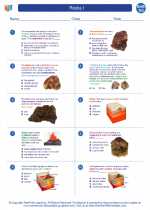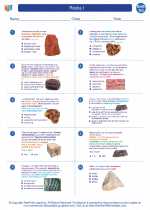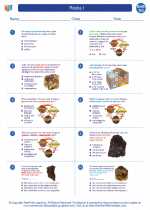Rocks I: Introduction to Rock Types
Overview
Rock is a naturally occurring solid aggregate of one or more minerals or mineraloids. Rocks are classified into three main types: igneous, sedimentary, and metamorphic. Understanding the properties and formation of these rock types is fundamental to Earth Science.
Igneous Rocks
Igneous rocks are formed from the solidification of molten rock material (magma or lava). They are classified into two main types: intrusive (plutonic) and extrusive (volcanic) rocks. Intrusive rocks form beneath the Earth's surface, while extrusive rocks form on the Earth's surface.
Study Points:
- Describe the process of igneous rock formation.
- Discuss the difference between intrusive and extrusive igneous rocks.
- Identify common examples of igneous rocks (e.g., granite, basalt).
Sedimentary Rocks
Sedimentary rocks are formed from the accumulation and lithification of sediment. This process involves weathering, erosion, deposition, and compaction. Sedimentary rocks often contain fossils and provide valuable information about Earth's history.
Study Points:
- Explain the formation of sedimentary rocks and the role of sedimentary environments.
- Discuss the significance of fossils in sedimentary rocks.
- Identify common examples of sedimentary rocks (e.g., limestone, sandstone).
Metamorphic Rocks
Metamorphic rocks are formed from the alteration of pre-existing rocks through heat, pressure, and chemical processes. This transformation occurs without melting the rock. Metamorphic rocks exhibit distinct foliation and often form in regional metamorphic settings.
Study Points:
- Describe the processes involved in the formation of metamorphic rocks.
- Explain the concept of foliation in metamorphic rocks.
- Identify common examples of metamorphic rocks (e.g., marble, slate).
Conclusion
Understanding the characteristics and formation of igneous, sedimentary, and metamorphic rocks is essential for comprehending Earth's dynamic geology. By studying the properties and processes associated with each rock type, you will gain a deeper insight into the geological history of our planet.
.◂Earth Science Worksheets and Study Guides High School. Rocks I

 Worksheet/Answer key
Worksheet/Answer key
 Worksheet/Answer key
Worksheet/Answer key
 Vocabulary/Answer key
Vocabulary/Answer key
 Vocabulary/Answer key
Vocabulary/Answer key
 Vocabulary/Answer key
Vocabulary/Answer key
